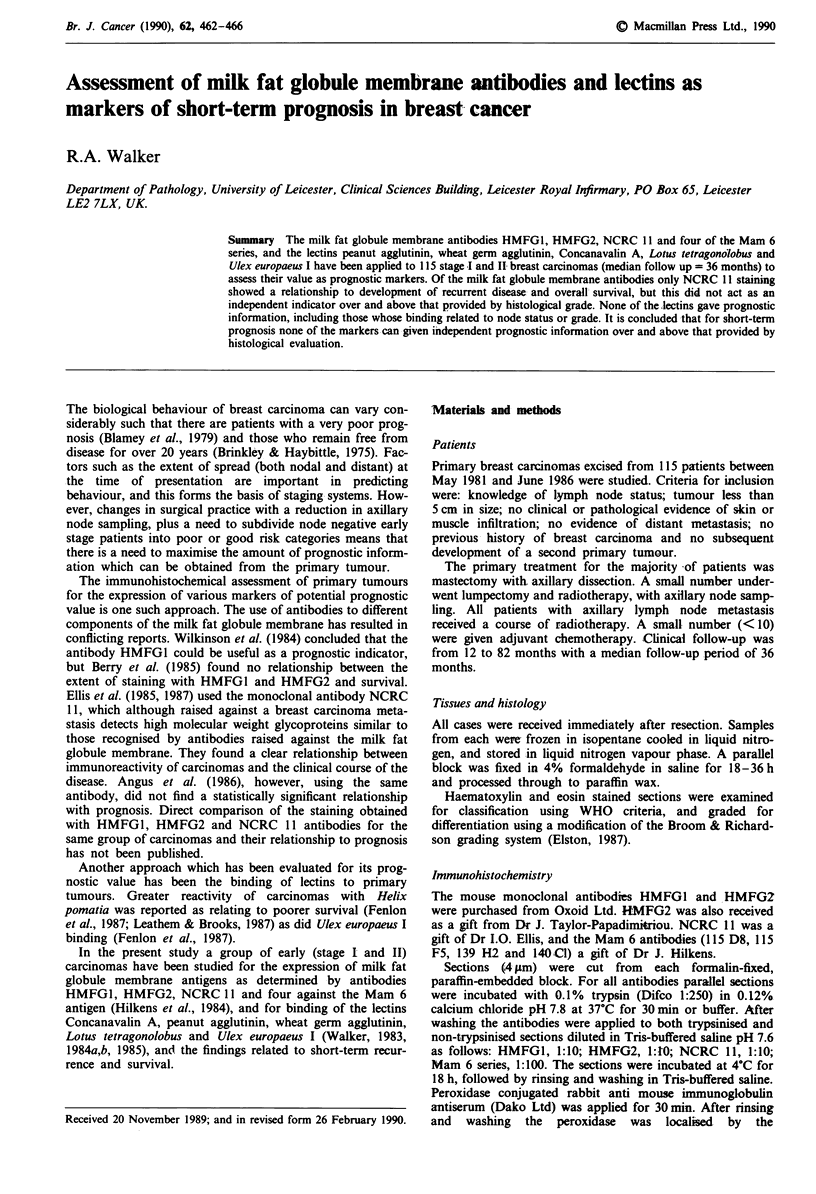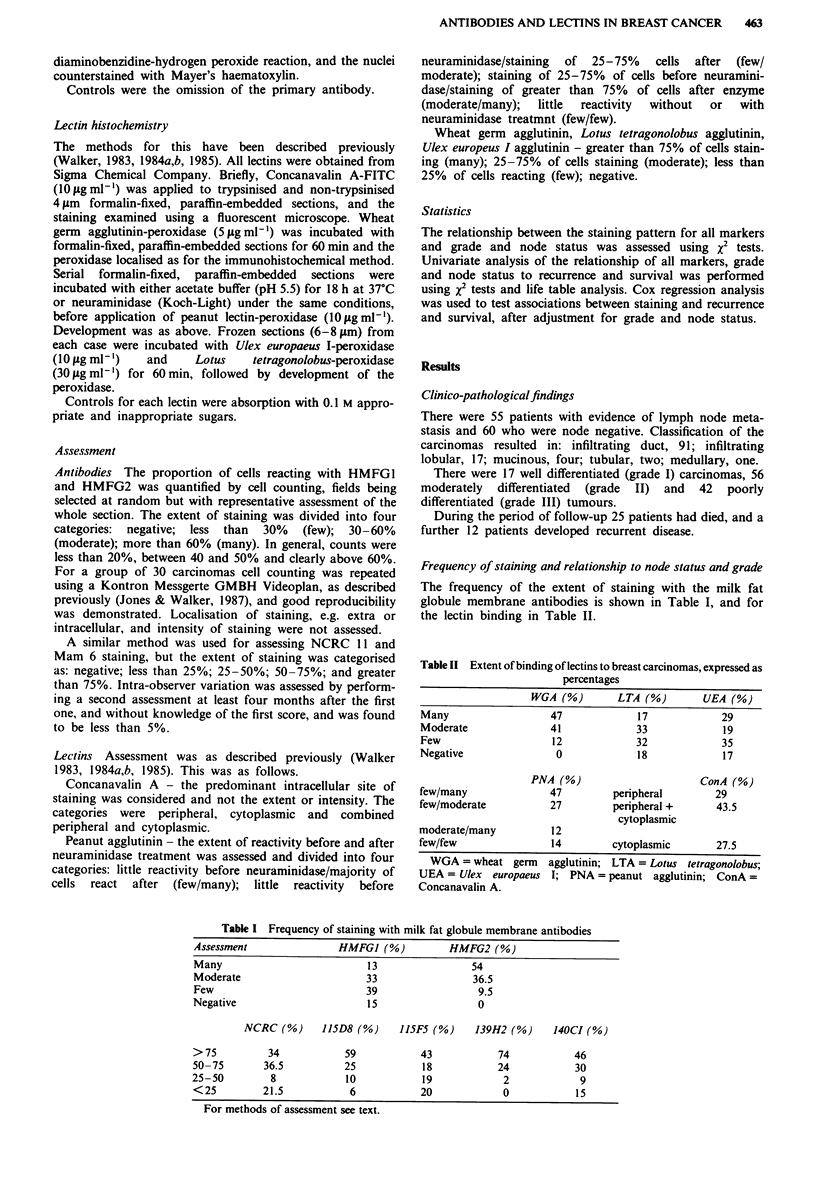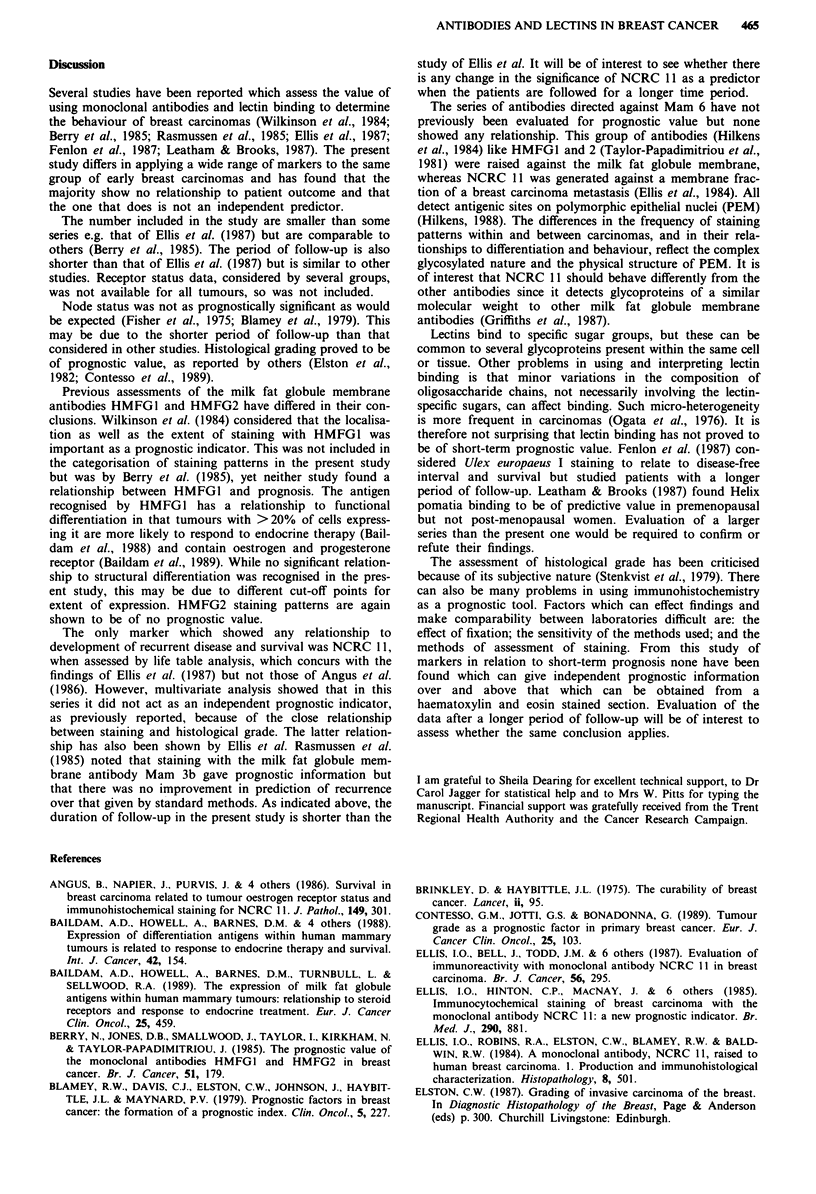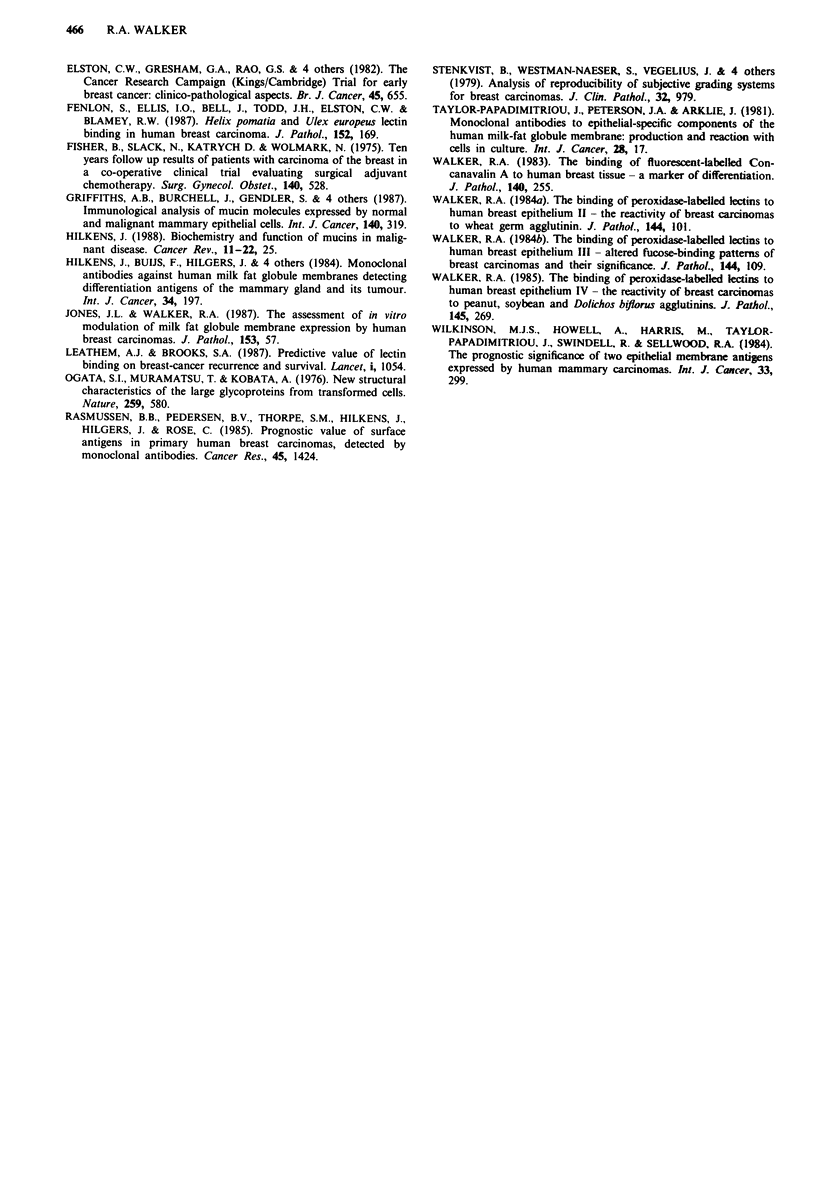Abstract
The milk fat globule membrane antibodies HMFG1, HMFG2, NCRC 11 and four of the Mam 6 series, and the lectins peanut agglutinin, wheat germ agglutinin, Concanavalin A, Lotus tetragonolobus and Ulex europaeus I have been applied to 115 stage I and II breast carcinomas (median follow up = 36 months) to assess their value as prognostic markers. Of the milk fat globule membrane antibodies only NCRC 11 staining showed a relationship to development of recurrent disease and overall survival, but this did not act as an independent indicator over and above that provided by histological grade. None of the lectins gave prognostic information, including those whose binding related to node status or grade. It is concluded that for short-term prognosis none of the markers can given independent prognostic information over and above that provided by histological evaluation.
Full text
PDF




Selected References
These references are in PubMed. This may not be the complete list of references from this article.
- Angus B., Napier J., Purvis J., Ellis I. O., Hawkins R. A., Carpenter F., Horne C. H. Survival in breast cancer related to tumour oestrogen receptor status and immunohistochemical staining for NCRC 11. J Pathol. 1986 Aug;149(4):301–306. doi: 10.1002/path.1711490406. [DOI] [PubMed] [Google Scholar]
- Baildam A. D., Howell A., Barnes D. M., Redford J., Healy K., Swindell R., Sellwood R. A. Expression of differentiation antigens within human mammary tumours is related to response to endocrine therapy and survival. Int J Cancer. 1988 Aug 15;42(2):154–158. doi: 10.1002/ijc.2910420203. [DOI] [PubMed] [Google Scholar]
- Baildam A. D., Howell A., Barnes D. M., Turnbull L., Sellwood R. A. The expression of milk fat globule antigens within human mammary tumours: relationship to steroid hormone receptors and response to endocrine treatment. Eur J Cancer Clin Oncol. 1989 Mar;25(3):459–467. doi: 10.1016/0277-5379(89)90258-7. [DOI] [PubMed] [Google Scholar]
- Berry N., Jones D. B., Smallwood J., Taylor I., Kirkham N., Taylor-Papadimitriou J. The prognostic value of the monoclonal antibodies HMFG1 and HMFG2 in breast cancer. Br J Cancer. 1985 Feb;51(2):179–186. doi: 10.1038/bjc.1985.27. [DOI] [PMC free article] [PubMed] [Google Scholar]
- Blamey R. W., Davies C. J., Elston C. W., Johnson J., Haybittle J. L., Maynard P. V. Prognostic factors in breast cancer -- the formation of a prognostic index. Clin Oncol. 1979 Sep;5(3):227–236. [PubMed] [Google Scholar]
- Brinkley D., Haybrittle J. L. The curability of breast cancer. Lancet. 1975 Jul 19;2(7925):95–97. doi: 10.1016/s0140-6736(75)90003-3. [DOI] [PubMed] [Google Scholar]
- Ellis I. O., Bell J., Todd J. M., Williams M., Dowle C., Robins A. R., Elston C. W., Blamey R. W., Baldwin R. W. Evaluation of immunoreactivity with monoclonal antibody NCRC 11 in breast carcinoma. Br J Cancer. 1987 Sep;56(3):295–299. doi: 10.1038/bjc.1987.192. [DOI] [PMC free article] [PubMed] [Google Scholar]
- Ellis I. O., Hinton C. P., MacNay J., Elston C. W., Robins A., Owainati A. A., Blamey R. W., Baldwin R. W., Ferry B. Immunocytochemical staining of breast carcinoma with the monoclonal antibody NCRC 11: a new prognostic indicator. Br Med J (Clin Res Ed) 1985 Mar 23;290(6472):881–883. doi: 10.1136/bmj.290.6472.881. [DOI] [PMC free article] [PubMed] [Google Scholar]
- Ellis I. O., Robins R. A., Elston C. W., Blamey R. W., Ferry B., Baldwin R. W. A monoclonal antibody, NCRC-11, raised to human breast carcinoma. 1. Production and immunohistological characterization. Histopathology. 1984 May;8(3):501–516. doi: 10.1111/j.1365-2559.1984.tb02360.x. [DOI] [PubMed] [Google Scholar]
- Elston C. W., Gresham G. A., Rao G. S., Zebro T., Haybittle J. L., Houghton J., Kearney G. The cancer research campaign (King's/Cambridge trial for early breast cancer: clinico-pathological aspects. Br J Cancer. 1982 May;45(5):655–669. doi: 10.1038/bjc.1982.106. [DOI] [PMC free article] [PubMed] [Google Scholar]
- Fenlon S., Ellis I. O., Bell J., Todd J. H., Elston C. W., Blamey R. W. Helix pomatia and Ulex europeus lectin binding in human breast carcinoma. J Pathol. 1987 Jul;152(3):169–176. doi: 10.1002/path.1711520305. [DOI] [PubMed] [Google Scholar]
- Fisher B., Slack N., Katrych D., Wolmark N. Ten year follow-up results of patients with carcinoma of the breast in a co-operative clinical trial evaluating surgical adjuvant chemotherapy. Surg Gynecol Obstet. 1975 Apr;140(4):528–534. [PubMed] [Google Scholar]
- Griffiths A. B., Burchell J., Gendler S., Lewis A., Blight K., Tilly R., Taylor-Papadimitriou J. Immunological analysis of mucin molecules expressed by normal and malignant mammary epithelial cells. Int J Cancer. 1987 Sep 15;40(3):319–327. doi: 10.1002/ijc.2910400307. [DOI] [PubMed] [Google Scholar]
- Hilkens J., Buijs F., Hilgers J., Hageman P., Calafat J., Sonnenberg A., van der Valk M. Monoclonal antibodies against human milk-fat globule membranes detecting differentiation antigens of the mammary gland and its tumors. Int J Cancer. 1984 Aug 15;34(2):197–206. doi: 10.1002/ijc.2910340210. [DOI] [PubMed] [Google Scholar]
- Leathem A. J., Brooks S. A. Predictive value of lectin binding on breast-cancer recurrence and survival. Lancet. 1987 May 9;1(8541):1054–1056. doi: 10.1016/s0140-6736(87)90482-x. [DOI] [PubMed] [Google Scholar]
- Ogata S. I., Muramatsu T., Kobata A. New structural characteristic of the large glycopeptides from transformed cells. Nature. 1976 Feb 19;259(5544):580–582. doi: 10.1038/259580a0. [DOI] [PubMed] [Google Scholar]
- Rasmussen B. B., Pedersen B. V., Thorpe S. M., Hilkens J., Hilgers J., Rose C. Prognostic value of surface antigens in primary human breast carcinomas, detected by monoclonal antibodies. Cancer Res. 1985 Mar;45(3):1424–1427. [PubMed] [Google Scholar]
- Stenkvist B., Westman-Naeser S., Vegelius J., Holmquist J., Nordin B., Bengtsson E., Eriksson O. Analysis of reproducibility of subjective grading systems for breast carcinoma. J Clin Pathol. 1979 Oct;32(10):979–985. doi: 10.1136/jcp.32.10.979. [DOI] [PMC free article] [PubMed] [Google Scholar]
- Taylor-Papadimitriou J., Peterson J. A., Arklie J., Burchell J., Ceriani R. L., Bodmer W. F. Monoclonal antibodies to epithelium-specific components of the human milk fat globule membrane: production and reaction with cells in culture. Int J Cancer. 1981 Jul 15;28(1):17–21. doi: 10.1002/ijc.2910280104. [DOI] [PubMed] [Google Scholar]
- Walker R. A. The binding of fluorescent-labelled concanavalin A to human breast tissue--a marker of differentiation. J Pathol. 1983 Jul;140(3):255–265. doi: 10.1002/path.1711400307. [DOI] [PubMed] [Google Scholar]
- Walker R. A. The binding of peroxidase-labelled lectins to human breast epithelium. II--The reactivity of breast carcinomas to wheat germ agglutinin. J Pathol. 1984 Oct;144(2):101–108. doi: 10.1002/path.1711440205. [DOI] [PubMed] [Google Scholar]
- Walker R. A. The binding of peroxidase-labelled lectins to human breast epithelium. III--Altered fucose-binding patterns of breast carcinomas and their significance. J Pathol. 1984 Oct;144(2):109–117. doi: 10.1002/path.1711440206. [DOI] [PubMed] [Google Scholar]
- Walker R. A. The binding of peroxidase-labelled lectins to human breast epithelium. IV--The reactivity of breast carcinomas to peanut, soy bean and Dolichos biflorus agglutinins. J Pathol. 1985 Mar;145(3):269–277. doi: 10.1002/path.1711450308. [DOI] [PubMed] [Google Scholar]
- Wilkinson M. J., Howell A., Harris M., Taylor-Papadimitriou J., Swindell R., Sellwood R. A. The prognostic significance of two epithelial membrane antigens expressed by human mammary carcinomas. Int J Cancer. 1984 Mar 15;33(3):299–304. doi: 10.1002/ijc.2910330304. [DOI] [PubMed] [Google Scholar]


